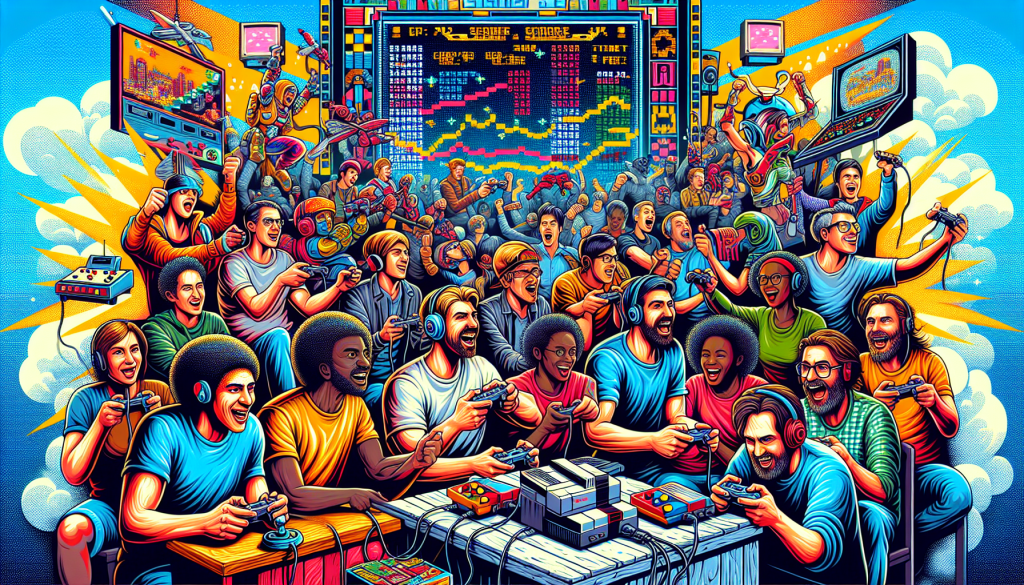The Fundamental Science behind Game Development
Have you ever wondered what makes your favorite video game so engaging? Or how game developers manage to create such realistic and immersive virtual worlds? The answer is simple: Science! Yes, you heard that right. The captivating world of game development is deeply rooted in the fundamental principles of science. Now, let’s dive a little deeper and uncover the science that fuels your favorite games.
Computational Science: The Backbone of Game Development
First things first, it’s important to understand that at its core, every video game is simply a high-tech piece of software. Therefore, the key to game development is computational science. This involves using computer models and simulations to solve complex problems and create dynamic and interactive environments. Essentially, it’s the art of telling a computer what you want it to do!
Game developers utilize a programming language to write down all the rules and instructions that dictate how the game will function. This code then gets translated into binary, a language that the computer can understand. So, whether you’re shooting aliens in a sci-fi game or building a virtual city, computational science powers it all!
Computer Graphics: Bringing Virtual Worlds to Life
Now, let’s talk about what makes video games look so good – computer graphics. This field of study focuses on how images and scenes are generated in computer systems. Game developers use algorithms and complex mathematical equations to generate 3D models, apply textures, and create lighting effects, all in real-time.
Furthermore, the advent of technologies such as Virtual Reality (VR) and Augmented Reality (AR) has taken computer graphics to another level. These technologies create even more immersive experiences by allowing players to interact with the game environment in new and exciting ways.
Artificial Intelligence: Powering Non-Player Characters
Ever wondered how the characters in your game seem so real? Or how they always manage to provide a challenging yet fun experience? That’s all thanks to artificial intelligence (AI).
AI in game development is used to create “intelligent” behaviors primarily in non-player characters (NPCs). These characters can learn from the player’s actions and adapt their strategy accordingly, making the game more dynamic and engaging.
So there you have it! Game development is a fascinating blend of various scientific disciplines, all working together to create the video games you know and love. Next time you boot up your favorite game, take a moment to appreciate the science that went into making it!
Note: The tag is a placeholder for a popular posts widget in WordPress. As this is a text-based output, it doesn’t have any effect here.Scientific Principles Driving Player Engagement
Ever wondered why some games have you hooked for hours while others bore you within minutes? Well, that’s the magic of scientific principles driving player engagement! The secret sauce of addictive gameplay isn’t just stunning graphics or a compelling storyline – it’s science!
Let’s delve into some of the key scientific principles that game developers use to keep us on our toes, finger twitching over the control buttons.
The Pleasure Principle
The first major principle is related to our brain’s reward system. It’s called the pleasure principle. In simple terms, we are more likely to repeat an action if it gives us pleasure. This is why game developers often reward players with points, virtual trophies, or access to new levels after completing certain tasks.
These rewards trigger the release of dopamine, a neurotransmitter that makes us feel good. And guess what? We want more of that feel-good sensation, so we keep playing!
The Zeigarnik Effect
Next up is the Zeigarnik Effect. This principle states that people remember uncompleted tasks better than completed ones. This is why many games have quests or missions. The nagging feeling of an unfinished task keeps us coming back to the game.
Fiero and the Challenge-Reward Cycle
Ever felt a rush of triumph after finally defeating that difficult boss or mastering a tricky level? That’s ‘fiero‘ – a term coined by researchers to describe the feeling of personal triumph over adversity. Game designers often use a challenge-reward cycle to stimulate fiero. They set tough challenges and provide substantial rewards for overcoming them. This cycle not only makes the gameplay more interesting but also induces addictive bouts of fiero.
Curiosity
Curiosity didn’t just kill the cat; it also keeps gamers engaged! Many games pique our interest by offering mystery boxes, hidden levels, or sneak peeks into future gameplay. It’s a simple but effective way to keep us curious – and playing!
Flow
Finally, there’s ‘flow‘. This principle refers to the state of total absorption in a task where the outside world seems to fade away. Game designers strive to create this state of flow by balancing the difficulty of challenges with the player’s skill level. Too easy, and you’re bored. Too hard, and you’re frustrated. But get the balance just right, and you’re in the zone, completely engrossed in the game.
So, the next time you find yourself glued to a game, remember – it’s not just the game; it’s the science behind it that’s got you hooked!
The Essential Role of Physics and Mathematics in Game Development
Have you ever stopped to wonder about the science behind your favorite games? How do characters move with such fluidity or bullets fly with such precision? The answer, my dear gamer, lies in the magical realms of physics and mathematics. Let’s take a fun-filled journey through these realms and discover how they make our beloved games come alive.
Physics: Making Game Worlds Realistic
In the world of game development, physics is the superstar. It’s what gives games a sense of realism and immersion. When a car in a racing game skids around a corner, or when an object in a platformer falls due to gravity, that’s game physics at work. It’s all about replicating the laws of nature within a digital world.
- Collision Detection: Ever wondered how your character can’t walk through walls or how two football players collide in a sports game? This is achieved through a physics concept known as collision detection. It determines when objects come into contact and reacts accordingly.
- Rigid Body Dynamics: This principle deals with the motion and collision of solid, non-deforming objects. It’s used to simulate realistic movements and interactions between objects in games, such as rolling a ball or knocking over a stack of boxes.
- Particle Systems: This physics concept is used to create effects like fire, smoke, and magic spells. It works by controlling a large number of tiny particles to create a visually impressive effect.
Mathematics: The Unseen Puppeteer
While physics makes games look real, mathematics makes games function. It’s the hidden puppet master, pulling the strings behind the scenes. Without math, games would be static, unresponsive, and far from enjoyable.
- Algebra: Basic algebra is used to create game mechanics, like scoring systems, character movement, and AI behavior. For example, a simple equation might determine how many points a player earns for each enemy defeated.
- Geometry: Ever marveled at the stunning landscapes and intricate architectures in games? Those are born from the creative application of geometry. It’s used in creating 3D models, mapping textures, and even in collision detection.
- Trigonometry: This branch of mathematics is used to rotate and scale game elements, or to calculate trajectories. For example, in a shooting game, trigonometry helps determine the path of a bullet.
From the realistic movements of characters to the mesmerizing effects and intuitive gameplay, physics and mathematics are the unsung heroes of game development. They work tirelessly behind the scenes, creating an immersive and engaging gaming experience for all of us. So, the next time you play a game, take a moment to appreciate the science that makes it all possible.
The Psychology of Gamification: How Science Engages Players
Ever wondered what makes online games, such as Fortnite or Minecraft, so enticing that they glue millions to their screens every day? The answer lies in the psychology of gamification – an art of applying scientific principles to make games more engaging. Let’s take a journey into how science is working behind the scenes to make your favorite games more enjoyable.
Understanding the Player’s Mind
First things first, game developers need to understand the player’s mind. That’s where the science of psychology comes into play. Understanding what motivates players, what they find rewarding, and what they find frustrating, are critical pieces of information that can help developers make their games more attractive.
For instance, a well-designed game provides a balance between challenge and reward. This aligns with operant conditioning – a psychological principle stating that behaviors followed by pleasant outcomes are likely to be repeated.
The Role of Dopamine
We can’t discuss the psychology of gaming without mentioning dopamine, the ‘feel-good’ neurotransmitter. Research shows that successful gaming actions, like defeating an enemy or achieving a new level, release dopamine in our brains. This chemical reaction makes us feel happy and motivated to play more. So, yes, games are literally designed to make you feel good!
The Power of Social Connections
Multiplayer games skillfully use the science of social psychology. They create virtual communities where players can form connections with like-minded individuals from around the world. This not only adds a social aspect to gaming but also increases our sense of belonging and satisfaction.
- Competition: Games like Fortnite pit players against each other, fueling our innate competitive nature.
- Cooperation: On the other hand, games like Minecraft promote collaboration, tapping into our desire to work together and achieve common goals.
The Magic of Progression
Another significant psychological factor that keeps players engaged is the sense of progression. Games are designed in a way that players start with simple tasks and gradually move towards more complex ones. This progression not only keeps the game interesting but also provides a sense of achievement.
Those shiny badges, new levels, or exclusive items you earn are not just virtual rewards. They are psychological milestones that make you feel accomplished and motivate you to keep going.
The Art of Balance
Lastly, a well-designed game maintains a fine balance between predictability and surprise. While players enjoy knowing what to do next, they also crave unexpected twists and turns. This balance keeps the excitement alive and makes gaming a thrilling experience.
So, next time you find yourself lost in the world of your favorite game, remember it’s not just the flashy graphics or the gripping storyline that’s keeping you hooked. It’s the brilliantly executed blend of scientific principles – a perfect cocktail of psychology, physiology, and social science that makes gaming so irresistible.












